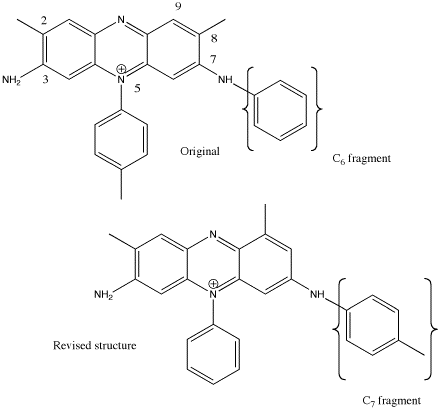Mauveine: The First Industrial Organic Fine-Chemical
Whilst the origin of the modern industrial revolution is
often traced to the Ironbridge Gorge northwest of Birmingham in
the UK, less credit is given to the birthplace of the
modern chemical industry. William Henry Perkin, who at the age of 18 had
accidentally produced the first
ever synthetic dye (aniline purple, better known as mauveine),
set up a factory on the banks of the Grand Union Canal in 1857
to produce it. This small dyeworks was located on a 6-acre site just
south of the Black Horse public House, in Greenford, West London. This
pub survives to this day, and remains a "local" for the pharmaceutical
giant, Glaxo Wellcome, which has its world headquarters nearby.
At the Royal Exhibition of 1862, Queen Victoria made an appearance
in a silk gown dyed with mauveine. In the Imperial College chemistry archives,
there is a sample of silk (approx 5 x 10 cm in size)
dyed with a batch of the original dye
synthesised in the 1850s, and a "penny lilac" postage stamp originally thought to
have been dyed with the
same compound. Curiously, the "corect" structure for the compound was only
finally put to rest as late as 1994 (see ref 1, appropriately enough, in
a journal named after Perkin himself). This turns out to be a mixture of the compound
shown and one other containing one more methyl group.
The new colour fell of of fashion in the late 1860s, but out of one of the
world's first chemistry "R&D" laboratories, Perkin discovered two new dyes, Britannia
Violet and Perkin's Green (the water in the nearby Grand Union Canal
was said to have turned a different colour every week- depending on what
dyes were being made at the time). In 1869, Perkin synthesised the vivid
natural red dye called Alizarin
(known chemically as sodium 9,10-dihydro-3,4-dihydroxy-9,10-dioxoanthracene-2-sulfonate).
The German company BASF reputedly beat him to the patenting
process by one day! Perkin and BASF came to an agreement over the manufacturing processes,
but the heyday of synthetic dye manufacturing in Greenford was now waning,
and in 1874, Perkin sold
his dyeworks to Brooke, Simpson and Spiller. It continued operation under
its new owners only until 1876, when it was sold
the tar makers Burt, Boulton and Haywood, the dye operations of which joined
the British Alizarine Company. This in turn became part of
ICI in 1931, and in more modern times became known as Zeneca, a company which can claim to be the
successor of Perkin. Nowadays in Manchester, there remains a significant collection of
interesting chemicals and other Perkin artefacts. Parts
of the original buildings
survived until the centenary celebrations in 1957, and the last
traces were demolished as recently as 1976. Nowadays, the site of
the laboratory for Perkin's dyeworks
serves as a distribution point for millions of loaves of bread and rolls
for West London.
Photographs of the Dyeworks site, the Black Horse Pub, and surroundings:





Further Reading:
- The paper in which the correct structure was finally reported;
O. Meth-Cohn and M. Smith, J. Chem. Soc., Perkin Transactions 1, 1994, 5.
- For a general account of the chemical history, see
O. Meth-Cohn and A. S. Travis, Chemistry in Britain, 1995, 31, 547.
- Anthony S. Travis "The rainbow makers: the origins of the synthetic dyestuffs industry in Western Europe". Bethlehem: Lehigh UP, 1983.
- Henry S. Rzepa, Molecules, 1998, 3, 94-99.
Henry Rzepa. December 17, 1995. Updated with photographs September 3, 1997
and corrections to the text, March 9, 1998.






